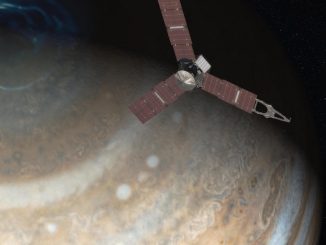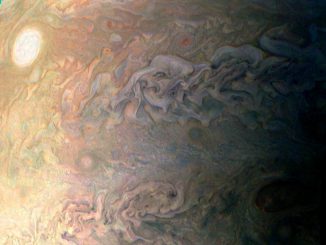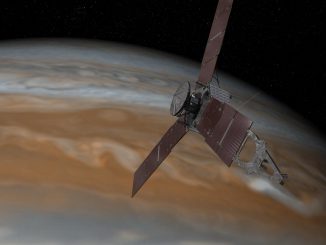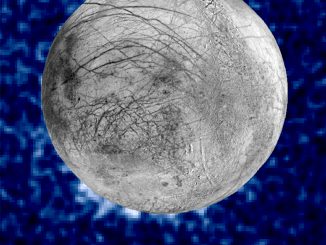
Jupiter


NASA’s Juno spacecraft to remain in current orbit around Jupiter
Concerns about the health of the Juno spacecraft’s main engine have compelled NASA managers to keep the research probe in its current arcing, high-altitude orbit around Jupiter, a decision that will delay the full science return from the $1.1 billion mission but should still allow it to meet all predetermined objectives.

Juno dives over Jupiter’s cloud tops with main engine still offline
NASA’s Juno spacecraft made a high-speed pass less than 3,000 miles over Jupiter’s turbulent clouds Thursday, taking dozens of pictures, measuring radiation and plasma waves, and peering deep inside the planet’s atmosphere, but officials still have not cleared the orbiter’s main engine for a planned maneuver to position the probe for improved science observations.

The Moon, Jupiter and star Spica line up at dawn on 19 January
Before sunrise on Thursday 19 January, observers in Western Europe can see an interesting celestial conjunction in the southern sky. At about 6am local time, the waning gibbous Moon, largest planet Jupiter and Spica — the brightest star in the constellation of Virgo — all lie in a line encompassed by the field of view of a typical 7x or 8x binocular.


Waning crescent Moon joins Jupiter in the dawn sky of 25 November
Around 6:30am GMT on Friday 25 November, as nautical twilight starts for the centre of the UK, the 25-day-old waning crescent Moon lies just 2½ degrees away from largest planet Jupiter low in the southeastern sky. This juxtaposition of the two brightest objects in the dawn sky will be nicely framed in a typical binocular.

Flying observatory SOFIA expanding frontiers in solar system and beyond
NASA’s Stratospheric Observatory for Infrared Astronomy (SOFIA) is a Boeing 747SP jetliner modified to carry a 100-inch diameter telescope to study the universe at infrared wavelengths that cannot be detected from ground-based observatories. SOFIA’s Science Cycle 5, which runs from February 2017 through January 2018, spans the entire field of astronomy from planetary science to extragalactic investigations.

See the old crescent Moon close to Jupiter in the morning sky
UK observers with a clear sky an hour before sunrise on Friday 28 October should look very low in the east-southeast to see the slim crescent of the 27-day-old Moon less than four lunar diameters away from largest planet Jupiter. The Moon and Jupiter are also joined by third-magnitude double star gamma (γ) Virginis, commonly known as Porrima.


Hubble spots possible water plumes erupting on Jupiter’s moon Europa
Astronomers using NASA’s Hubble Space Telescope have imaged what may be water vapour plumes erupting 125 miles (200 kilometres) off the surface of Jupiter’s moon Europa. Europa has a huge global ocean containing twice as much water as Earth’s oceans, but it is protected by a layer of extremely cold and hard ice of unknown thickness.
